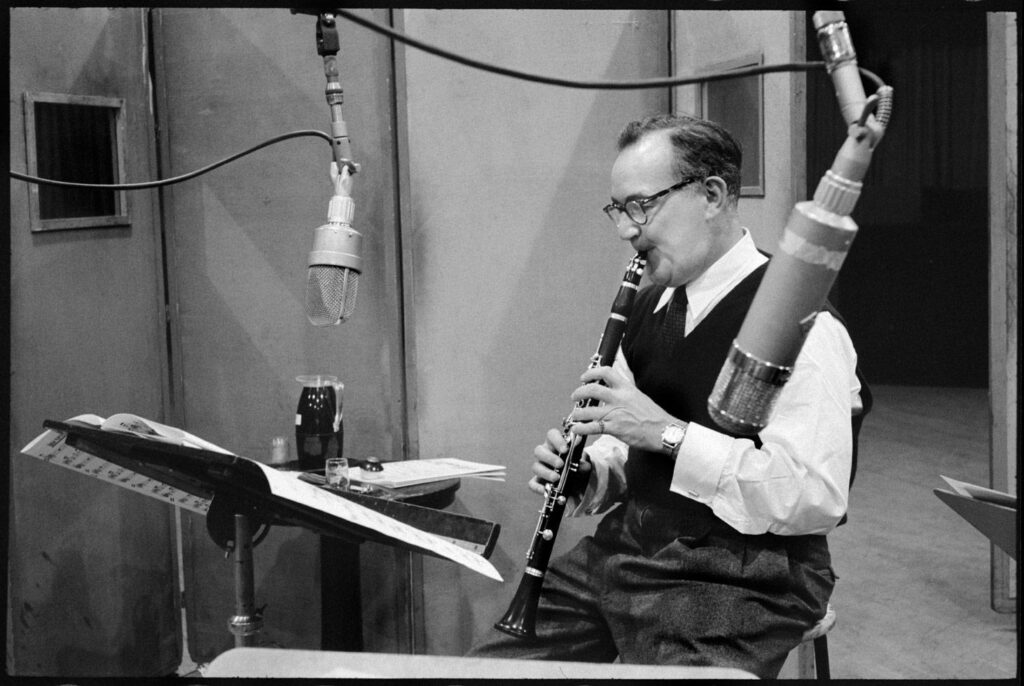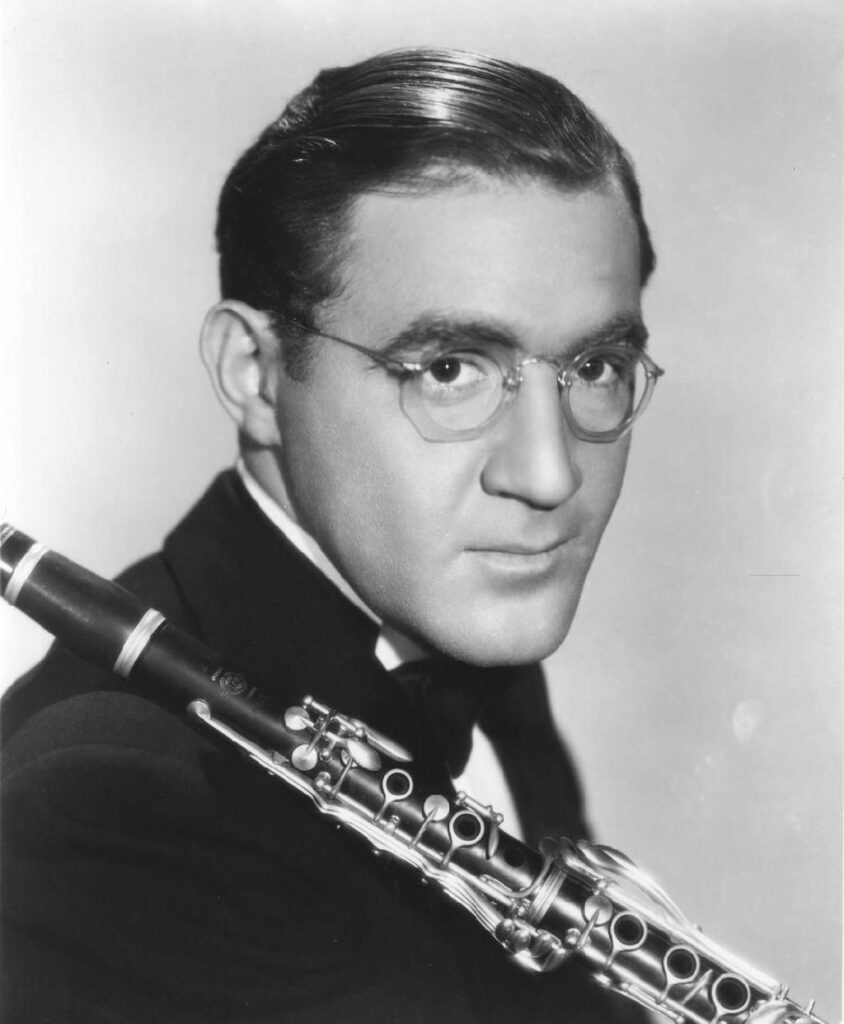Benny Goodman is a personality without which it is impossible to imagine music. He was often called the king of swing. Those who gave Benny this nickname had everything to think so. Even today there is no doubt that Benny Goodman is a musician from God.
Benny Goodman was more than just a renowned clarinetist and bandleader. The musician created iconic orchestras known for their amazing cohesion and integration.
The musician was famous for his enormous social influence. Black musicians played in Benny's orchestra at a time of great bigotry and segregation.

Childhood and youth
Benny was born into a family of Jewish immigrants from the Russian Empire, David Gutman (from Belaya Tserkov) and Dora Rezinskaya-Gutman (according to other sources, Georgian or Grinskaya, from Kovno).
From early childhood he was in love with music. At the age of 10, the clarinet fell into the hands of Benny. A year later, the boy professionally played the compositions of the famous Ted Lewis.
Goodman moonlighted as a street musician. When the boy was a teenager, he already had his pocket money. During this period, Benny first realized the growing influence of music on him. Soon he dropped out of high school and devoted himself to creativity. Almost immediately after the decision to leave the educational institution, he joined the orchestra of the trumpeter Bix Beiderbeck.
By the way, Benny Goodman is the first white musician who gained recognition among black jazzmen. It was worth it. Of course, even then everyone who heard the guy's game understood that he would go far.
The creative path of Benny Goodman
In the fall of 1929, the jazz musician left the orchestra and moved to New York. Benny didn't just leave the band. He wanted to build a solo career.
Soon, the young musician was recording songs on the radio, playing in the orchestras of Broadway musicals, and writing musical compositions. And he performed them himself, with the support of improvised ensembles.
Some time later, Benny Goodman recorded a song, thanks to which he gained his first popularity. We are talking about the musical composition He's Not Worth Your Tear. The track was recorded in 1931 by Meloton Records and featured singer Scrappy Lambert.
Soon the musician signed his first contract with Columbia Records. In 1934, Ain't Cha Glad?, Riffin' the Scotch, Ol' Pappy, I Ain't Lazy, I'm Just Dreamin' topped the country's prestigious music charts.
Recognition and the beginning of the "era of swing"
Music lovers and fans gladly accepted the compositions presented by the artist. The fact that the songs were in the chart, of course, increased the reputation of Benny Goodman. What can you expect from a musician who has already released a dozen worthy works? Of course, a new masterpiece. Composition Moon Glow (1934) took the 1st position of the charts. It was a resounding success.
The success of this song was repeated by Take My Word and Bugle Call Rag. After the end of the contract with the music hall, Benny was invited to NBC radio to host the Saturday program Let's Dance.
For 6 months of work, Benny Goodman hit the top of the music charts a dozen more times. This success was repeated after the musician began working with the record company RCA Victor.
But soon the program, where Benny Goodman was the host, was closed. This event bordered on a strike of workers at the National Biscuit Company - the sponsor of the same radio program. Thus, Goodman and his team were left without work.
These are not the best of times for the United States of America. The country was in a real depression. Benny Goodman and his orchestra, in the literal sense of the word, were left without funds. Soon the musician decided to go on a big tour in private cars.
On the way through the towns of the Midwest, the orchestra's concerts were not very popular. Most of the audience left the hall after they realized that the musicians were playing swing music, not dance music.
Hard times for Benny Goodman
The musicians were practically penniless. They fell into depression. Many simply left the orchestra because they needed something to feed their families. Performances were no longer profitable.
The band finally made it to Los Angeles. The musician this time decided not to experiment. They played not their own, but dance music. In the hall, the audience took it without enthusiasm, languidly trampled in the aisles, a murmur began. The band's drummer yelled, "Guys, what the hell are we doing? In case this is the last performance, let's make sure that we don't feel ashamed to see ourselves off the stage..."
The musicians stopped playing dance music and played the usual swing. That evening they worked at 100%. The audience was delighted. Music lovers "roared" with joy and euphoria. Many have recognized the popular tracks of Benny Goodman.

Some time later, Benny Goodman moved to the Chicago area. There, with performer Helen, Ward wrote a number of "juicy" compositions, which in the future became recognized classics. It's about the songs:
- It's Been So Long;
- goody-goody;
- The Glory of Love;
- These Foolish Things Remind Me of You;
- You Turned the Tables on Me.
Soon Benny Goodman was again invited to lead the program. He became the host of the Camel Caravan show. In the autumn of 1936, his orchestra made its first television appearance. Then the musician returned to New York.
Peak of Benny Goodman's Musical Career
A year later, the musical compositions of Benny Goodman again hit the top positions of the music charts. Stunning popularity fell upon the musician. Soon the orchestra led by the musician took part in the filming of the movie "Hotel Hollywood".
The Savoy Dance Hall, which was visited by spectators of various nationalities, at that time hosted the Battles of the Jazz Bands, where Chick Webb's orchestra often defeated rivals. Goodman, realizing his importance, challenged Chick Webb.
New York held its breath in anticipation of the long-awaited musical duel. Spectators could not wait for the clash of two titans. And on the appointed evening, the Savoy dance hall is full. The hall accommodated more than 4 thousand people. The audience was waiting. It was something!
None of the spectators present had heard anything like this before! The musicians tried so hard that it seems that the air was charged with this powerful energy.
Despite the originality and virtuosity of the musicians of the Goodman Orchestra, Chick Webb's orchestra was the best. When the opposing musicians started playing, the members of Benny Goodman's orchestra simply waved their hand. They knew that Chick Webb would win.
The peak of Benny Goodman's musical career came in 1938. It was in this year that the musician held a famous concert at the Carnegie Hall in New York. Then the musician performed not only songs from his own repertoire, but also Al Jolson's Avalon track.
That same year, Goodman's songs were in the top 14 more than 10 times. Popular songs include I Let a Song Go out of My Heart, Don't Be That Way and Sing, Sing, Sing (With a Swing). The last song was very popular. She was subsequently inducted into the Grammy Hall of Fame.
Activities of Benny Goodman in the post-war period
The entry of the United States of America into World War II and the strike initiated by the American Federation of Musicians forced Benny to temporarily stop his cooperation with Victor RCA.
The musician managed to finish work on some songs even before the strike. The composition Taking Chance on Love deserves special attention.
Then he tried his hand at cinema. He has appeared in films such as Stage Door Canteen, The Gang's All Here and Sweet and Low-Down. Benny perfectly got used to the role and talentedly conveyed the state of his characters.
In the winter of 1944, the jazzman, along with his quintet, became a member of the Broadway show The Seven Arts. The show aroused considerable interest among the audience and withstood 182 performances.
A year later, the ban on sound recording was lifted. Benny Goodman returned to his native recording studio. Already in April, the Hot Jazz compilation was released, which instantly hit the top 10 of the best records.

The next compilation Gotta Be This or That was also successful. On the recording of the album, Goodman himself performed the vocal part for the first time. This event is captured in the song Symphony.
Soon Benny moved to the recording studio Capitol Records. In addition, he took part in the filming of the movie A Song is Born. In the same period of time, his next musical experiments began.
Swing replaced bebop, and Goodman's orchestra recorded several compositions in this style. A huge surprise was the information that Goodman was disbanding his orchestra. This event took place in 1949. In the future, the musician collected an orchestra, but only for the so-called one-time "actions".
By the beginning of the 1950s, Benny practically did not conduct composing activities. At the same time, his collection Jazz Concert at Carnegie Hall appeared. The musician “invested” a live recording of the famous performance on January 16, 1938 into this disc.
The subsequent compilation Jazz Concerto No. 2 was also warmly received by fans and music critics. A year later, the musician's discography was replenished with another album, The Benny Goodman Story.
The last years of Benny Goodman's life
Since the mid-1950s, Benny Goodman has made a number of tours around the world. In the early 1960s, the musician visited the territory of the Soviet Union. He was impressed by the warm reception from his fans. As a result, he released the album "Benny Goodman in Moscow".
In 1963, musicians who had performed with Goodman as far back as the early 1930s gathered at RCA Victor Studios. We are talking about Gene Krupe, Teddy Wilson and Lionel Hampton. The musicians united not just like that, but to record the album "Together Again!". The album did not go unnoticed by fans.
The years made themselves felt, so the musician practically did not record songs. The only significant work was the compilation "Benny Goodman Today", recorded in 1971 in Stockholm. Shortly before his death, Benny Goodman received the prestigious Grammy Award. The album "Let's dance!" won. (based on the music for the radio program of the same name).
Benny Goodman died on June 13, 1986 in New York. He has had heart problems for a long time. He died of a heart attack and is buried in Stamford.
Naturally, Benny Goodman left behind a rich creative legacy. It included many compilations that were recorded at the recording studios Columbia and RCA Victor.
There is a series of discs from the musician's personal archive, released by Music Master, and various individual recordings. And although the musician has long been dead, his tracks are immortal.



